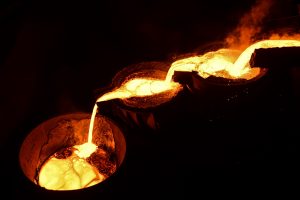
By Fred McMann, Metallurgist
The breathe of stainless steels (SS) available for purchase is exceptionally wide. Generally speaking, when the word “Stainless” is mentioned for technical applications, it is assumed that the material is impervious to corrosion and will forever remain bright and shiny. While the expectation is not without merit, the selection of the correct stainless or at least in the proper “family” of stainless is very important so that the resulting performance is not disappointing. Note: some stainless steels do corrode in a short time, some are magnetic, some are non-magnetic, and some are bio-compatible and used for medical implants and so on.
Ferritic Stainless Steels are commonly alloyed with a minimum Chromium content of 12%. The rest of the chemistry is essentially Iron. These steels are generally magnetic, and have fair corrosion resistance, but cannot be thermally hardened. The group includes grades such as 409, 409Cb, 403, and 430. There are free machining versions of these grades that makes them attractive to some general market applications. The cost of these grades is low when compared to other higher end grades of stainless.
Tubular exhaust pipe and associated fittings in automotive is a very common application for 409 and 409 Cb. Machined acorn nuts from 430F bar which are found in consumer products is another application. These grades are drawn into pipe, formed into machining bar, or used as cold heading wire (normally 430) for manufacturing into various commercial parts. Pole pieces and armatures for solenoids are very commonly machined from cold formed out of 430FR SS which is praised for its good magnetic properties for low coercive force and magnetic flux density.
Martensitic Stainless Steels is a classification of metals that are thermally hardenable and are magnetic. The corrosion resistance of this family of SS is on a par with Ferritic’s in that the corrosion resistance is only fair and approaching good depending on the grade selected. Martensitic grades are more highly alloyed with carbon which allows them to be thermally hardened. The highest hardness one can expect to obtain after thermally hardening is from 440-C which is Rc 60.
In comparison, 416 stainless can only be hardened to Rc 36/38. In between, there are many other grades including 420 and Trimrite, (TM Carpenter Technology), which are popular and used for many commercial, consumer and medical surgical instrument applications. Generally speaking the Martensitics are alloyed with Carbon, Chromium, and sometimes low amounts of Molybdenum, Nickel and Sulfur. As with all SS, the minimum % of Chromium is 12%.
Austenitic Stainless Steel is possibly the most recognizable family of SS alloys and I like to refer to them as “kitchen sink” type materials. I say that because one immediately thinks of the family kitchen sink and its resistance to corrosion and durability (alloy type 301 FYI). The grades are alloyed with Chromium, Nickel and sometimes Molybdenum, Titanium, and other elements to give different levels of corrosion resistance, formability, machinability, and durability. This family of SS is not thermally hardenable but can be cold worked to achieve some decent strength levels.
18-8 is a common nickname for 304 type SS and that means 18% chromium, and 8% nickel. Most Austenitics fall into this base chemistry. The corrosion resistance of this family is categorized as good to very good. There are a few grades in this family which are bio-compatible and implantable which can be found in the 316 grouping. A future article from Vested Metals will go into more detail on medical application and grades. Product offerings can be in pipe, tubing, machining bar, and strip and plate. I also want to mention that this family is essentially non-magnetic, depending on chemistry and mill processing.
Precipitation Hardening (PH) Stainless Steel is another very recognizable family of alloys which are characterized by good corrosion resistance, and offers strength levels after age hardening, to levels which exceed the Austenitic grades. Most of these grades are para-magnetic in that they are slightly magnetic but are closer to the Austenitics in non-magnetic attributes. In other words they will show a slight attraction to a magnet but nothing on the order to the attraction of the Ferritics or Martensitics.
17-4 PH is a very common PH alloy which can be aged to H900 to about Rc 44 (17 is for 17% Chromium and 4 is for 4% nickel). There are other elements in lower %, which metallurgically allow and force the age hardening precipitation reaction such as copper and titanium. There are many iterations of this alloy family which can offer greater corrosion resistance and strength levels above 17-4. 17-7 PH for instance can be manufactured and aged hardened to hardness levels above Rc 50, in wire and cold forming applications. The alloys are thermally “aged” to its high strength.
The aging is actually at a very manageable temperature of around 900/1100 F and thus warpage and heat treat scale is kept to a minimum. This process is very important in finely machined and produced parts so that they can hold their dimensions easily after aging. Custom 455 and Custom 465 are very popular grades which have properties above common 17-4 PH. This class of alloys is commonly used in medical instruments, some automotive, and industrial applications. They are available in strip, plate, machining bar and cold forming wire.
I hope you find this article helpful towards obtaining a greater understanding of the General properties of Stainless Steels.
Fred McMann/Technical Services/Vested Metals